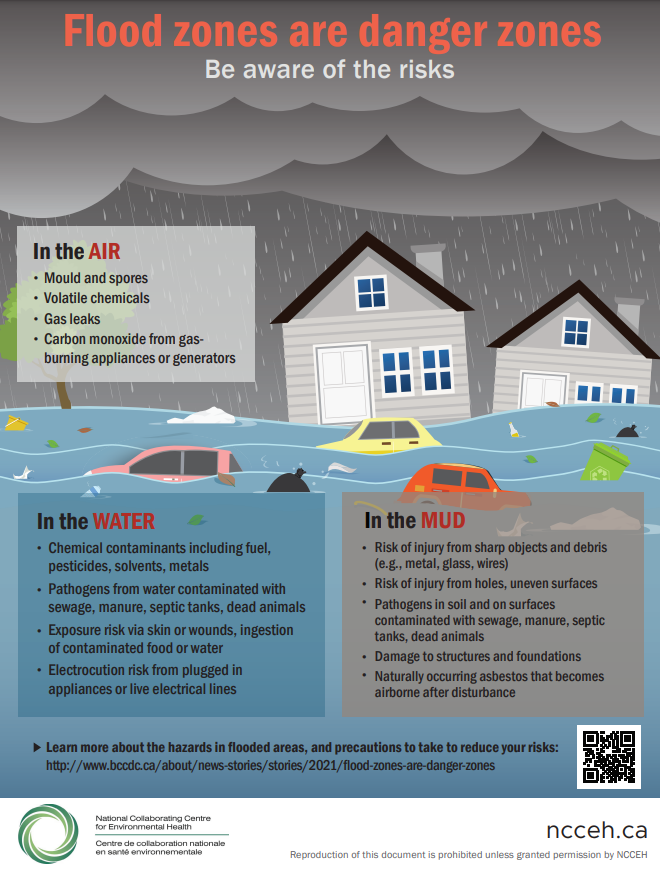Numerous hazards may be present in a flood zone, and they may be difficult to spot due to the surrounding damage and the emotion of returning home. Here are some of the key hazards to be aware of before entering a flood zone.
Respect evacuation orders. Never re-enter the flood zone unless emergency management officials have indicated that you may do so.
Chemical and microbiological contamination. Floodwaters may have broken open vessels containing fuel, fertilizers, or other common household chemicals. Similarly, flood water may carry dangerous pathogens after mixing with sewage, municipal or agricultural waste, or animal carcasses.
Wash your hands often and
keep minor wounds clean and covered. If someone exposed to floodwater becomes sick or a wound becomes infected, see a doctor right away.
Identify and discard foods that may have been contaminated by floodwater or have been left unrefrigerated.
Clean up after a flood: Follow this guidance on how to discard or clean and disinfect any non-food items touched by floodwater. Be sure to follow the guidance from BCCDC on
using cleaners and disinfectants safely.
Contaminated drinking water. Flood water may have contaminated your well or the public drinking water system. Follow all public health advisories on public drinking water.
In flood-affected areas, well water should be considered “not for human consumption” until the well is assessed, and the water is disinfected and tested.
Never use flood water or contaminated drinking water for drinking, preparation of baby food, personal hygiene (e.g., washing or brushing teeth) or washing dishes or surfaces.
- Flooded septic systems. Like drinking water systems, septic systems may need to be
assessed before use if the field has become saturated during a flood.
- Asbestos. Asbestos is present in the building materials used for many older homes. When asbestos fibres are released to the surrounding air, they can be inhaled and may cause many serious long-term health problems.
Other indoor air contaminants. Structures that have been closed and damp for even a few days may develop mould. The US CDC provides detailed resources on
removing mould safely, or you may opt to hire a professional remediator. Be on the lookout for other
indoor air quality hazards, Wear
respiratory protection, such as an N95 respirator.
Unsafe structures. Buildings may have shifted off their foundations or suffered other damage that may render them unstable. Debris, including hazardous or contaminated items, may have been deposited onto you property. It is important to carefully
inspect the outside of your home before entering, and then also inspect the inside.
Electrical hazards. Downed power lines, damaged electrical equipment, or using electric tools in standing water can be lethal. See
BC Hydro for guidance on restoring electricity to a flooded home and see this
helpful resource for identifying other hazards.
Gas hazards. Floodwaters may have damaged gas appliances and shifted propane tanks or broken gas lines. If you smell gas, leave the building and call 911. Contact
Fortis BC for more information on restoring service and see this
helpful resource for identifying other hazards. If the gas is turned off, do not attempt to turn it on yourself.
Carbon monoxide poisoning. Some people may attempt to re-occupy homes before services have been restored. If so, never attempt to use devices like gas ranges, camp stoves or other combustion devices to heat the home, as this may result in
lethal carbon monoxide poisoning. Likewise, never use a generator in or near the building.
Live animals. Wounded or disoriented animals may have taken refuge in your property. Enter cautiously, make lots of noise, and leave an escape route.
Continue to seek care. If you have been evacuated or displaced because of floods or mudslides and are running short on medications, you can get an emergency supply from any pharmacy in B.C. Contact 8-1-1 or your healthcare provider if you have questions about your health or seek in-person medical care if needed.
For more information on flood prevention, response, and recovery, see the Province's website
Be prepared for floods and PreparedBC's
Flood Preparedness Guide.
Visit HealthLink BC for more information on
Flooding and Your Health.

Click to open (PDF)

